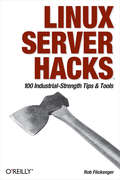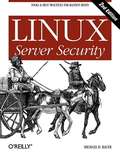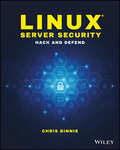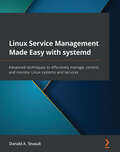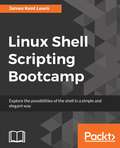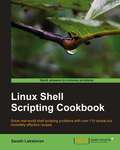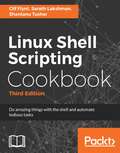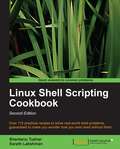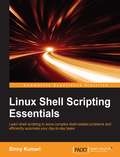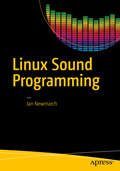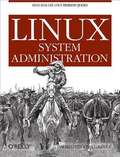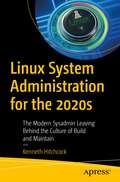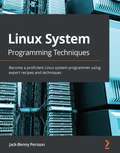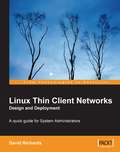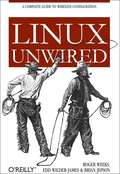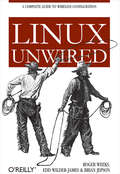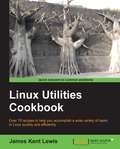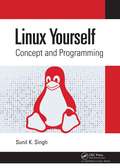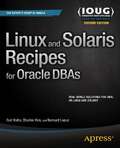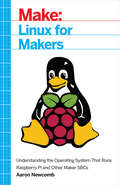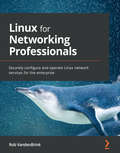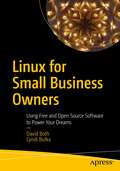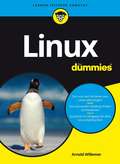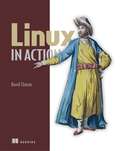- Table View
- List View
Linux Server Hacks: 100 Industrial-Strength Tips and Tools
by Rob FlickengerA competent system administrator knows that a Linux server is a high performance system for routing large amounts of information through a network connection. Setting up and maintaining a Linux server requires understanding not only the hardware, but the ins and outs of the Linux operating system along with its supporting cast of utilities as well as layers of applications software. There's basic documentation online but there's a lot beyond the basics you have to know, and this only comes from people with hands-on, real-world experience. This kind of "know how" is what we sought to capture in Linux Server Hacks.Linux Server Hacks is a collection of 100 industrial-strength hacks, providing tips and tools that solve practical problems for Linux system administrators. Every hack can be read in just a few minutes but will save hours of searching for the right answer. Some of the hacks are subtle, many of them are non-obvious, and all of them demonstrate the power and flexibility of a Linux system. You'll find hacks devoted to tuning the Linux kernel to make your system run more efficiently, as well as using CVS or RCS to track the revision to system files. You'll learn alternative ways to do backups, how to use system monitoring tools to track system performance and a variety of secure networking solutions. Linux Server Hacks also helps you manage large-scale Web installations running Apache, MySQL, and other open source tools that are typically part of a Linux system.O'Reilly's new Hacks Series proudly reclaims the term "hacking" for the good guys. Hackers use their ingenuity to solve interesting problems. Rob Flickenger is an experienced system administrator, having managed the systems for O'Reilly Network for several years. (He's also into community wireless networking and he's written a book on that subject for O'Reilly.) Rob has also collected the best ideas and tools from a number of other highly skilled contributors.Written for users who already understand the basics, Linux Server Hacks is built upon the expertise of people who really know what they're doing.
Linux Server Security, 2nd Edition
by Michael D. BauerLinux Server Security , 2nd Edition expertly conveys to administrators and developers the tricks of the trade that can help them avoid serious security breaches. It covers both background theory and practical step-by-step instructions for protecting a server that runs Linux. Packed with examples, this must-have book lets the good guys stay one step ahead of potential adversaries.
Linux Server Security: Hack and Defend
by Chris BinnieLearn how to attack and defend the world’s most popular web server platform Linux Server Security: Hack and Defend presents a detailed guide for experienced admins, aspiring hackers and other IT professionals seeking a more advanced understanding of Linux security. Written by a 20-year veteran of Linux server deployment this book provides the insight of experience along with highly practical instruction. The topics range from the theory of past, current, and future attacks, to the mitigation of a variety of online attacks, all the way to empowering you to perform numerous malicious attacks yourself (in the hope that you will learn how to defend against them). By increasing your understanding of a hacker’s tools and mindset you're less likely to be confronted by the all-too-common reality faced by many admins these days: someone else has control of your systems. Master hacking tools and launch sophisticated attacks: perform SQL injections, deploy multiple server exploits and crack complex passwords. Defend systems and networks: make your servers invisible, be confident of your security with penetration testing and repel unwelcome attackers. Increase your background knowledge of attacks on systems and networks and improve all-important practical skills required to secure any Linux server. The techniques presented apply to almost all Linux distributions including the many Debian and Red Hat derivatives and some other Unix-type systems. Further your career with this intriguing, deeply insightful, must-have technical book. Diverse, broadly-applicable and hands-on practical, Linux Server Security: Hack and Defend is an essential resource which will sit proudly on any techie's bookshelf.
Linux Service Management Made Easy with systemd: Advanced techniques to effectively manage, control, and monitor Linux systems and services
by Donald A. TevaultA comprehensive guide for teaching system administrators, developers, and security professionals how to create their own systemd units and maintain system securityKey FeaturesMaintain and troubleshoot systemd services with easeLearn to create, modify, and reload service files and use systemd utilitiesUse cgroups to control resource usage and enhance securityBook DescriptionLinux Service Management Made Easy with systemd will provide you with an in-depth understanding of systemd, so that you can set up your servers securely and efficiently.This is a comprehensive guide for Linux administrators that will help you get the best of systemd, starting with an explanation of the fundamentals of systemd management.You'll also learn how to edit and create your own systemd units, which will be particularly helpful if you need to create custom services or timers and add features or security to an existing service.Next, you'll find out how to analyze and fix boot-up challenges and set system parameters. An overview of cgroups that'll help you control system resource usage for both processes and users will also be covered, alongside a practical demonstration on how cgroups are structured, spotting the differences between cgroups Version 1 and 2, and how to set resource limits on both.Finally, you'll learn about the systemd way of performing time-keeping, networking, logging, and login management. You'll discover how to configure servers accurately and gather system information to analyze system security and performance.By the end of this Linux book, you'll be able to efficiently manage all aspects of a server running the systemd init system.What you will learnUse basic systemd utilities to manage a systemCreate and edit your own systemd unitsCreate services for Podman-Docker containersEnhance system security by adding security-related parametersFind important information with journaldAnalyze boot-up problemsConfigure system settings with systemd utilitiesWho this book is forThis book is best suited for Linux administrators who want to learn more about maintaining and troubleshooting Linux servers. It will also be useful for aspiring administrators studying for a Linux certification exam, developers looking to learn how to create systemd unit files, and security administrators who want to understand the security settings that can be used in systemd units and how to control resource usage with cgroups. Before you dive into this book, you'll need a solid working knowledge of basic Linux commands.
Linux Shell Scripting Bootcamp
by James Kent LewisA quick and straightforward approach to writing shell scripts to accomplish different types of tasks on a Linux system. About This Book • Understand expressions and variables and how to use them practically • Familiarize yourself with the various text filtering tools available in Linux • A fast-paced and concise guide that gets you well versed with linux shell scripting. Who This Book Is For This book is for both GNU/Linux users who want to do amazing things with the shell and for advanced users looking for ways to make their lives with the shell more productive. What You Will Learn • Get acquainted with the basics of a shell script to serve as a refresher for more advanced topics • Learn different ways to create and run a script • Discuss the passing and verification of parameters, along with the verification of other items. • Understand the different forms of conditions and loops, and go over the sleep command in detail • Learn about different ways to handle the reporting of return codes • Create an interactive script by reading the keyboard and use subroutines and interrupts • Create scripts to perform backups and go over the use of encryption tools and checksums • Use wget and curl in scripts to get data directly from the Internet In Detail Linux Shell Scripting Bootcamp is all about learning the essentials of script creation, validating parameters, and checking for the existence of files and other items needed by the script. We will use scripts to explore iterative operations using loops and learn different types of loop statements, with their differences. Along with this, we will also create a numbered backup script for backup files. Further, you will get well-versed with how variables work on a Linux system and how they relate to scripts. You'll also learn how to create and call subroutines in a script and create interactive scripts. The most important archive commands, zip and tar, are also discussed for performing backups. Later, you will dive deeper by understanding the use of wget and curl scripts and the use of checksum and file encryption in further chapters. Finally, you will learn how to debug scripts and scripting best practices that will enable you to write a great code every time! By the end of the book, you will be able to write shell scripts that can dig data from the web and process it efficiently. Style and approach This book is all about fast and intensive learning. This means we don't waste time in helping readers get started. The new content is basically about filling in with highly-effective examples to build new things, solving problems in newer and unseen ways, and solving real-world examples.
Linux Shell Scripting Cookbook
by Sarath LakshmanThis book is written in cookbook style and it offers learning through recipes with examples and illustrations. Each recipe contains step-by-step instructions about everything necessary to execute a particular task. The book is designed so that you can read it from start to end for beginner's or just open up any chapter and start following the recipes as a reference for advanced users.If you are a beginner or an intermediate user who wants to master the skill of quickly writing scripts to perform various tasks without reading the entire man pages, this book is for you. You can start writing scripts and one-liners by simply looking at the similar recipe and its descriptions without any working knowledge of shell scripting or Linux. Intermediate/advanced users as well as system adminstrators/ developers and programmers can use this book as a reference when they face problems while coding.
Linux Shell Scripting Cookbook - Third Edition
by Shantanu Tushar Sarath Lakshman Clif FlyntDo amazing things with the shell About This Book • Become an expert in creating powerful shell scripts and explore the full possibilities of the shell • Automate any administrative task you could imagine, with shell scripts • Packed with easy-to-follow recipes on new features on Linux, particularly, Debian-based, to help you accomplish even the most complex tasks with ease Who This Book Is For If you are a beginner or an intermediate Linux user who wants to master the skill of quickly writing scripts and automate tasks without reading the entire man pages, then this book is for you. You can start writing scripts and one-liners by simply looking at the relevant recipe and its descriptions without any working knowledge of shell scripting or Linux. Intermediate / advanced users, system administrators / developers, and programmers can use this book as a reference when they face problems while coding. What You Will Learn • Interact with websites via scripts • Write shell scripts to mine and process data from the Web • Automate system backups and other repetitive tasks with crontab • Create, compress, and encrypt archives of your critical data. • Configure and monitor Ethernet and wireless networks • Monitor and log network and system activity • Tune your system for optimal performance • Improve your system's security • Identify resource hogs and network bottlenecks • Extract audio from video files • Create web photo albums • Use git or fossil to manage revision control and interact with FOSS projects • Create and maintain Linux containers and Virtual Machines • Run a private Cloud server In Detail The shell is the most powerful tool your computer provides. Despite having it at their fingertips, many users are unaware of how much the shell can accomplish. Using the shell, you can generate databases and web pages from sets of files, automate monotonous admin tasks such as system backups, monitor your system's health and activity, identify network bottlenecks and system resource hogs, and more. This book will show you how to do all this and much more. This book, now in its third edition, describes the exciting new features in the newest Linux distributions to help you accomplish more than you imagine. It shows how to use simple commands to automate complex tasks, automate web interactions, download videos, set up containers and cloud servers, and even get free SSL certificates. Starting with the basics of the shell, you will learn simple commands and how to apply them to real-world issues. From there, you'll learn text processing, web interactions, network and system monitoring, and system tuning. Software engineers will learn how to examine system applications, how to use modern software management tools such as git and fossil for their own work, and how to submit patches to open-source projects. Finally, you'll learn how to set up Linux Containers and Virtual machines and even run your own Cloud server with a free SSL Certificate from letsencrypt.org. Style and approach This book will take you through useful real-world recipes designed to make your daily life easier when working with the shell.
Linux Shell Scripting Cookbook, Second Edition
by Shantanu Tushar Sarath LakshmanThis book is written in a Cookbook style and it offers learning through recipes with examples and illustrations. Each recipe contains step-by-step instructions about everything necessary to execute a particular task. The book is designed so that you can read it from start to end for beginners, or just open up any chapter and start following the recipes as a reference for advanced users.If you are a beginner or an intermediate user who wants to master the skill of quickly writing scripts to perform various tasks without reading the entire manual, this book is for you. You can start writing scripts and one-liners by simply looking at the similar recipe and its descriptions without any working knowledge of shell scripting or Linux. Intermediate/advanced users as well as system administrators/ developers and programmers can use this book as a reference when they face problems while coding.
Linux Shell Scripting Essentials
by Sinny KumariLearn shell scripting to solve complex shell-related problems and to efficiently automate your day-to-day tasks About This Book * Familiarize yourself with the terminal by learning about powerful shell features * Automate tasks by writing shell scripts for repetitive work * Packed with easy-to-follow, hands-on examples to help you write any type of shell script with confidence Who This Book Is For This book is aimed at administrators and those who have a basic knowledge of shell scripting and who want to learn how to get the most out of writing shell scripts. What You Will Learn * Write effective shell scripts easily * Perform search operations and manipulate large text data with a single shell command * Modularize reusable shell scripts by creating shell libraries * Redirect input, output, and errors of a command or script execution to other streams * Debug code with different shell debugging techniques to make your scripts bug-free * Manage processes, along with the environment variables needed to execute them properly * Execute and embed other languages in your scripts * Manage creation, deletion, and search operations in files In Detail Shell scripting is a quick method to prototype complex applications or problems. Shell scripts are a collection of commands to automate tasks, usually those for which the user has a repeated need, when working on Linux-based systems. Using simple commands or a combination of them in a shell can solve complex problems easily. This book starts with the basics, including essential commands that can be executed on Linux systems to perform tasks within a few nanoseconds. You'll learn to use outputs from commands and transform them to show the data you require. Discover how to write shell scripts easily, execute script files, debug, and handle errors. Next, you'll explore environment variables in shell programming and learn how to customize them and add a new environment. Finally, the book walks you through processes and how these interact with your shell scripts, along with how to use scripts to automate tasks and how to embed other languages and execute them. Style and approach This book is a pragmatic guide to writing efficient shell programs, complete with hands-on examples and tips.
Linux Sound Programming
by Jan NewmarchProgram audio and sound for Linux using this practical, how-to guide. You will learn how to use DSPs, sampled audio, MIDI, karaoke, streaming audio, and more. Linux Sound Programming takes you through the layers of complexity involved in programming the Linux sound system. You'll see the large variety of tools and approaches that apply to almost every aspect of sound. This ranges from audio codecs, to audio players, to audio support both within and outside of the Linux kernel. What You'll Learn Work with sampled audio Handle Digital Signal Processing (DSP) Gain knowledge of MIDI Build a Karaoke-like application Handle streaming audio Who This Book Is For Experienced Linux users and programmers interested in doing multimedia with Linux.
Linux System Administration
by Tom Adelstein Bill LubanovicIf you're an experienced system administrator looking to acquire Linux skills, or a seasoned Linux user facing a new challenge, Linux System Administration offers practical knowledge for managing a complete range of Linux systems and servers. The book summarizes the steps you need to build everything from standalone SOHO hubs, web servers, and LAN servers to load-balanced clusters and servers consolidated through virtualization. Along the way, you'll learn about all of the tools you need to set up and maintain these working environments. Linux is now a standard corporate platform with users numbering in the hundreds of millions, and there is a definite shortage of talented administrators. Linux System Administration is ideal as an introduction to Linux for Unix veterans, MCSEs, and mainframe administrators, and as an advanced (and refresher) guide for existing Linux administrators who will want to jump into the middle of the book. Inside, you'll learn how to: Set up a stand-alone Linux server Install, configure, maintain, and troubleshoot a DNS server using BIND Build an Internet server to manage sites, perform email and file transfers, and more Set up an email service for a small-to-medium-sized site, complete with authentication Install and configure Apache, PHP, and MySQL on a web server built from scratch Combine computers into a load-balanced Apache web server cluster based on the free Linux Virtual Server Set up local network services from distributed file systems to DHCP services, gateway services, print services, user management and more Use Linux virtualization with Xen or VMWare to run multiple kernels on one piece of hardware; manage each kernel's access to processor time, devices, and memory Create shell scripts and adapt them for your own needs Back up and restore data with rsync, tar, cdrecord , Amanda, and MySQL tools Linux System Administration is not only knowledgeable and practical, but convenient. The ingredients for this book had been scattered throughout mailing lists, forums, and discussion groups, as well as books, periodicals, and the experiences of colleagues. Everything is now in one handy guide. In the course of their research, the authors also solved many problems whose solutions were completely undocumented. They now pass their lessons on to you.
Linux System Administration for the 2020s: The Modern Sysadmin Leaving Behind the Culture of Build and Maintain
by Kenneth HitchcockBuild and manage large estates, and use the latest OpenSource management tools to breakdown a problems. This book is divided into 4 parts all focusing on the distinct aspects of Linux system administration. The book begins by reviewing the foundational blocks of Linux and can be used as a brief summary for new users to Linux and the OpenSource world. Moving on to Part 2 you'll start by delving into how practices have changed and how management tooling has evolved over the last decade. You’ll explore new tools to improve the administration experience, estate management and its tools, along with automation and containers of Linux. Part 3 explains how to keep your platform healthy through monitoring, logging, and security. You'll also review advanced tooling and techniques designed to resolve technical issues. The final part explains troubleshooting and advanced administration techniques, and less known methods for resolving stubborn problems.With Linux System Administration for the 2020s you'll learn how to spend less time doing sysadmin work and more time on tasks that push the boundaries of your knowledge. What You'll Learn Explore a shift in culture and redeploy rather than fix Improve administration skills by adopting modern toolingAvoid bad practices and rethink troubleshootingCreate a platform that requires less human intervention Who This Book Is ForEveryone from sysadmins, consultants, architects or hobbyists.
Linux System Programming Techniques: Become a proficient Linux system programmer using expert recipes and techniques
by Jack-Benny PerssonFind solutions to all your problems related to Linux system programming using practical recipes for developing your own system programsKey FeaturesDevelop a deeper understanding of how Linux system programming worksGain hands-on experience of working with different Linux projects with the help of practical examplesLearn how to develop your own programs for LinuxBook DescriptionLinux is the world's most popular open source operating system (OS). Linux System Programming Techniques will enable you to extend the Linux OS with your own system programs and communicate with other programs on the system. The book begins by exploring the Linux filesystem, its basic commands, built-in manual pages, the GNU compiler collection (GCC), and Linux system calls. You'll then discover how to handle errors in your programs and will learn to catch errors and print relevant information about them. The book takes you through multiple recipes on how to read and write files on the system, using both streams and file descriptors. As you advance, you'll delve into forking, creating zombie processes, and daemons, along with recipes on how to handle daemons using systemd. After this, you'll find out how to create shared libraries and start exploring different types of interprocess communication (IPC). In the later chapters, recipes on how to write programs using POSIX threads and how to debug your programs using the GNU debugger (GDB) and Valgrind will also be covered. By the end of this Linux book, you will be able to develop your own system programs for Linux, including daemons, tools, clients, and filters.What you will learnDiscover how to write programs for the Linux system using a wide variety of system callsDelve into the working of POSIX functionsUnderstand and use key concepts such as signals, pipes, IPC, and process managementFind out how to integrate programs with a Linux systemExplore advanced topics such as filesystem operations, creating shared libraries, and debugging your programsGain an overall understanding of how to debug your programs using ValgrindWho this book is forThis book is for anyone who wants to develop system programs for Linux and gain a deeper understanding of the Linux system. The book is beneficial for anyone who is facing issues related to a particular part of Linux system programming and is looking for specific recipes or solutions.
Linux System Programming: Talking Directly to the Kernel and C Library
by Robert LoveWrite software that draws directly on services offered by the Linux kernel and core system libraries. With this comprehensive book, Linux kernel contributor Robert Love provides you with a tutorial on Linux system programming, a reference manual on Linux system calls, and an insider’s guide to writing smarter, faster code.Love clearly distinguishes between POSIX standard functions and special services offered only by Linux. With a new chapter on multithreading, this updated and expanded edition provides an in-depth look at Linux from both a theoretical and applied perspective over a wide range of programming topics, including:A Linux kernel, C library, and C compiler overviewBasic I/O operations, such as reading from and writing to filesAdvanced I/O interfaces, memory mappings, and optimization techniquesThe family of system calls for basic process managementAdvanced process management, including real-time processesThread concepts, multithreaded programming, and PthreadsFile and directory managementInterfaces for allocating memory and optimizing memory accessBasic and advanced signal interfaces, and their role on the systemClock management, including POSIX clocks and high-resolution timers
Linux Thin Client Networks Design and Deployment
by David RichardsThe book consists of HOW-TOs for all elements of setting up a thin client network, as well as expert advice on decision making, based on the authors experience creating a thin client network for the city of Largo, Florida. The book is for System Administrators interested in designing and setting up a Linux thin client network and provides enough knowledge to understand how the technology works, make decisions about deployment, and then implement a stable work environment.
Linux Unwired
by Brian Jepson Edd Dumbill Roger WeeksIn Linux Unwired , you'll learn the basics of wireless computing, from the reasons why you'd want to go wireless in the first place, to setting up your wireless network or accessing wireless data services on the road. The book provides a complete introduction to all the wireless technologies supported by Linux. You'll learn how to install and configure a variety of wireless technologies to fit different scenarios, including an office or home network and for use on the road. You'll also learn how to get Wi-Fi running on a laptop, how to use Linux to create your own access point, and how to deal with cellular networks, Bluetooth, and Infrared. Other topics covered in the book include: Connecting to wireless hotspots Cellular data plans you can use with Linux Wireless security, including WPA and 802.1x Finding and mapping Wi-Fi networks with kismet and gpsd Connecting Linux to your Palm or Pocket PC Sending text messages and faxes from Linux through your cellular phone Linux Unwired is a one-stop wireless information source for on-the-go Linux users. Whether you're considering Wi-Fi as a supplement or alternative to cable and DSL, using Bluetooth to network devices in your home or office,or want to use cellular data plans for access to data nearly everywhere, this book will show you the full-spectrum view of wireless capabilities of Linux, and how to take advantage of them.
Linux Unwired: A Complete Guide to Wireless Configuration
by Brian Jepson Roger Weeks Edd Wilder-JamesIn Linux Unwired, you'll learn the basics of wireless computing, from the reasons why you'd want to go wireless in the first place, to setting up your wireless network or accessing wireless data services on the road. The book provides a complete introduction to all the wireless technologies supported by Linux. You'll learn how to install and configure a variety of wireless technologies to fit different scenarios, including an office or home network and for use on the road. You'll also learn how to get Wi-Fi running on a laptop, how to use Linux to create your own access point, and how to deal with cellular networks, Bluetooth, and Infrared.Other topics covered in the book include:Connecting to wireless hotspotsCellular data plans you can use with LinuxWireless security, including WPA and 802.1xFinding and mapping Wi-Fi networks with kismet and gpsdConnecting Linux to your Palm or Pocket PCSending text messages and faxes from Linux through your cellular phoneLinux Unwired is a one-stop wireless information source for on-the-go Linux users. Whether you're considering Wi-Fi as a supplement or alternative to cable and DSL, using Bluetooth to network devices in your home or office, or want to use cellular data plans for access to data nearly everywhere, this book will show you the full-spectrum view of wireless capabilities of Linux, and how to take advantage of them.
Linux Utilities Cookbook
by James Kent LewisA Cookbook-style guide packed with examples and illustrations, it offers organized learning through recipes and step-by-step instructions. The book is designed so that you can pick exactly what you need, when you need it.Written for anyone that would like to familiarize themselves with Linux. This book is perfect migrating from Windows to Linux and will save your time and money, learn exactly how to and where to begin working with Linux and troubleshooting in easy steps.
Linux Yourself: Concept and Programming
by Sunil K. SinghNumerous people still believe that learning and acquiring expertise in Linux is not easy, that only a professional can understand how a Linux system works. Nowadays, Linux has gained much popularity both at home and at the workplace. Linux Yourself: Concept and Programming aims to help and guide people of all ages by offering a deep insight into the concept of Linux, its usage, programming, administration, and several other connected topics in an easy approach. This book can also be used as a textbook for undergraduate/postgraduate engineering students and others who have a passion to gain expertise in the field of computer science/information technology as a Linux developer or administrator. The word "Yourself" in the title refers to the fact that the content of this book is designed to give a good foundation to understand the Linux concept and to guide yourself as a good Linux professional in various platforms. There are no prerequisites to understand the contents from this book, and a person with basic knowledge of C programming language will be able to grasp the concept with ease. With this mindset, all the topics are presented in such a way that it should be simple, clear, and straightforward with many examples and figures. Linux is distinguished by its own power and flexibility, along with open-source accessibility and community as compared to other operating systems, such as Windows and macOS. It is the author’s sincere view that readers of all levels will find this book worthwhile and will be able to learn or sharpen their skills. KEY FEATURES Provides a deep conceptual learning and expertise in programming skill for any user about Linux, UNIX, and their features. Elaborates GUI and CUI including Linux commands, various shells, and the vi editor Details file management and file systems to understand Linux system architecture easily Promotes hands-on practices of regular expressions and advanced filters, such as sed and awk through many helpful examples Describes an insight view of shell scripting, process, thread, system calls, signal, inter-process communication, X Window System, and many more aspects to understand the system programming in the Linux environment Gives a detailed description of Linux administration by elaborating LILO, GRUB, RPM-based package, and program installation and compilation that can be very helpful in managing the Linux system in a very efficient way Reports some famous Linux distributions to understand the similarity among all popular available Linux and other features as case studies
Linux and Solaris Recipes for Oracle DBAs
by Darl Kuhn Charles Kim Bernard LopuzLinux and Solaris Recipes for Oracle DBAs, 2nd Edition is an example-based book on managing Oracle Database under Linux and Solaris. The book is written for database administrators who need to get work done and lack the luxury of curling up fireside with a stack of operating-system documentation. What this book provides instead is task-oriented coverage designed around the needs of the Oracle Database Administrator. Find the right chapter. Look up the task to perform. See the solution. Implement the solution straight away in your own environment. Get the job done. New in this edition is coverage of Oracle's own Solaris operating system. Oracle Corporation has been working diligently to bring commonality between Solaris and Linux, and this book takes advantage of those efforts to provide task-oriented solutions that work on common distributions of Linux such as Red Hat Enterprise Linux and Oracle Enterprise Linux while also accommodating the growing number of Oracle Solaris customers. Examples in the book match the tasks DBAs perform daily, even hourly. Solutions come first in the book, but always are followed by close explanations of the details. Database administrators won't go wrong with Linux and Solaris Recipes for Oracle DBAs. It's the book to buy if you're after clear and reliable examples to help in getting the job done, and getting home to your family. Takes you directly from problem to solution Covers the "right" mix of operating-system tasks for database administrators Respects your time by being succinct and to-the-point Includes coverage of Solaris in addition to common Linux distributions What you'll learn Execute Linux and Solaris commands applicable to Oracle Database. Automate critical DBA tasks via operating-system shell scripts. Monitor, tune, and optimize Linux and Solaris servers for Oracle. Setup a VirtualBox environment for the Oracle database. Perform system administration tasks relevant to Oracle Database. Remotely (and securely!) manage Oracle on Linux and Solaris. Who this book is for Linux and Solaris Recipes for Oracle DBAs is a book for Oracle database administrators who want to expertly operate Oracle databases on the Linux and Solaris operating systems. If you're new to Linux and Solaris and can benefit from detailed examples showing how to perform tasks that Oracle DBAs perform on Linux and Solaris servers, then this book is what you need to help you get the job done, and get home on time. Table of Contents 1. Getting Started 2. Working in the Shell 3. Managing Processes and Users 4. Creating and Editing Files 5. Managing Files and Directories 6. Archiving and Compressing Files 7. Shell Scripting 8. Analyzing Server Performance 9. Viewing and Configuring System Resources 10. Automating Jobs 11. Installing and Upgrading Oracle Software 12. Virtualization Tasks 13. Optimizing Linux for Oracle Databases 14. Working Securely Across a Network 15. Managing X-Windows 16. Managing Remote Servers with VNC 17. Appendix A. Understanding RAID Concepts 18. Appendix B. Managing Log Files
Linux for Makers: Understanding the Operating System That Runs Raspberry Pi and Other Maker SBCs
by Aaron NewcombLinux is a powerful open-source operating system that has been around for many years and is widely used for running servers and websites. But most students and Makers encounter it for the first time when they are working on projects with their Raspberry Pi or similar single-board computers (SBCs) such as BeagleBone Black or Intel Galileo. Linux for Makers is the first book that explains the Linux operating system specifically for Makers, as opposed to programmers and administrators. By gaining a deeper understanding of Linux, Makers can add another useful tool to their kit that will help them build their projects more easily.Written with the Maker in mind, this book will focus mostly on Rasbian running on the Raspberry Pi as it is the most prolific in the ecosystem today. However most of the topics covered will apply broadly to other Linux distributions and will be called out when they may differ. Many times users cut and paste from a website tutorial into the Linux command line without understanding what they are actually doing only to be frustrated when they want to modify or tweak something to suit their needs. Also, many Makers shy away from using the Raspberry Pi or similar board because they feel Linux is too foreign and they think using a command line will be more difficult than using a GUI. This book aims to overcome those fears and provide a foundation for further learning and exploration. To that end, this book will focus on the basic principles that a Maker would need to know as opposed to other resources that go into detail that is not particularly relevant to building projects.
Linux for Networking Professionals: Securely configure and operate Linux network services for the enterprise
by Rob VandenBrinkGet to grips with the most common as well as complex Linux networking configurations, tools, and services to enhance your professional skillsKey FeaturesLearn how to solve critical networking problems using real-world examplesConfigure common networking services step by step in an enterprise environmentDiscover how to build infrastructure with an eye toward defense against common attacksBook DescriptionAs Linux continues to gain prominence, there has been a rise in network services being deployed on Linux for cost and flexibility reasons. If you are a networking professional or an infrastructure engineer involved with networks, extensive knowledge of Linux networking is a must.This book will guide you in building a strong foundation of Linux networking concepts. The book begins by covering various major distributions, how to pick the right distro, and basic Linux network configurations. You'll then move on to Linux network diagnostics, setting up a Linux firewall, and using Linux as a host for network services. You'll discover a wide range of network services, why they're important, and how to configure them in an enterprise environment. Finally, as you work with the example builds in this Linux book, you'll learn to configure various services to defend against common attacks. As you advance to the final chapters, you'll be well on your way towards building the underpinnings for an all-Linux datacenter.By the end of this book, you'll be able to not only configure common Linux network services confidently, but also use tried-and-tested methodologies for future Linux installations.What you will learnUse Linux as a troubleshooting and diagnostics platformExplore Linux-based network servicesConfigure a Linux firewall and set it up for network servicesDeploy and configure Domain Name System (DNS) and Dynamic Host Configuration Protocol (DHCP) services securelyConfigure Linux for load balancing, authentication, and authorization servicesUse Linux as a logging platform for network monitoringDeploy and configure Intrusion Prevention Services (IPS)Set up Honeypot solutions to detect and foil attacksWho this book is forThis book is for IT and Windows professionals and admins looking for guidance in managing Linux-based networks. Basic knowledge of networking is necessary to get started with this book.
Linux for Small Business Owners: Using Free and Open Source Software to Power Your Dreams
by David Both Cyndi BulkaLearn how you can take complete control and run your small business with powerful, free open source software (FOSS). This book introduces small business owners to the power and security of Linux and other FOSS tools to manage any small business as well as the many advantages it has over expensive, proprietary software. While exploring the reasons for using Free Open Source Software, you'll investigate the assertion that, “The value of any software lies in its usefulness not in its price,” set forth by Linux Torvalds, the creator of Linux. This book examines the use of Linux and also the other Free Open Source Software you need to meet your business challenges including the usual accounting, Email, web browsing, word-processing tasks. You will be introduced to advanced tools such as those that enable you to create audio and video clips you can use to promote your business or that can even be your primary product, such as how-to instruction.Most small business owners perform many tasks including that of administering their computers. This book shows you how to find and install new software you need to run your business and keep it up to date using the tools already provided by Linux and the secure, trusted repositories available online. It also explores how to decide which tasks to do in-house and which you might want to sub out to external resources such as advertising and contact services to attract and keep customers. Linux for Small Business Owners provides some logic, reason, and explanation for each of the steps that are needed and the tools used to implement Linux in your small business. It is a detailed guide to removing Windows from your computers and installing Linux and some commonly used open source software like the LibreOffice suite of programs, accounting, and other software useful to many small businesses. It also provides the information and tools necessary to manage and maintain Linux and applications up-to-date and secure.What You'll Learn Understand what the term "free/open source" means and how you can apply it to your business.Look at the operational and financial advantages of using Free Open Source Software instead of expensive, proprietary software.See why you will never need to pay for anti-virus and anti-malware software again.Replace expensive software like Microsoft Office with open source tools such as LibreOffice Review the factors required to make an informed decision about switching to Linux.Install new applications, updates to Linux, and the application software.Explore why backups are critical, how to create them, and how to use them to restore lost data. Who This Book Is For Ideal for small business owners and owner-operated small businesses looking to streamline operations, save money, time and energy managing the common problems associated with using more popular operating systems.
Linux für Dummies (Für Dummies)
by Arnold V. WillemerWollen Sie wissen, was es mit Linux auf sich hat und warum es unter Kennern eine so große Fangemeinde hat? Ziehen Sie freie Softwareanbieter den kommerziellen vor? Trauen Sie sich noch nicht zu, die eingefahrenen Pfade zu verlassen, wollen das aber? Arnold Willemer zeigt Ihnen, wie Sie zu einem eigenen Linux-System kommen. Er bevorzugt die Distribution Linux Mint MATE, da sie sehr einfach in der Bedienung ist, stellt aber auch andere Distributionen vor. Sie erfahren auch, was Sie dann mit Ihrem neuen Computer anfangen können ? Textverarbeitung, Tabellenkalkulation, Mailen und Surfen ?, wie Sie ein kleines Familien-Netzwerk einrichten und wie Sie Ihr System pflegen.
Linux in Action
by David ClintonSummaryLinux in Action is a task-based tutorial that will give you the skills and deep understanding you need to administer a Linux-based system. This hands-on book guides you through 12 real-world projects so you can practice as you learn. Each chapter ends with a review of best practices, new terms, and exercises. Purchase of the print book includes a free eBook in PDF, Kindle, and ePub formats from Manning Publications.About the TechnologyYou can't learn anything without getting your hands dirty including Linux. Skills like securing files, folders, and servers, safely installing patches and applications, and managing a network are required for any serious user, including developers, administrators, and DevOps professionals. With this hands-on tutorial, you'll roll up your sleeves and learn Linux project by project.About the BookLinux in Action guides you through 12 real-world projects, including automating a backup-and-restore system, setting up a private Dropbox-style file cloud, and building your own MediaWiki server. You'll try out interesting examples as you lock in core practices like virtualization, disaster recovery, security, backup, DevOps, and system troubleshooting. Each chapter ends with a review of best practices, new terms, and exercises. What's insideSetting up a safe Linux environmentManaging secure remote connectivityBuilding a system recovery devicePatching and upgrading your systemAbout the ReaderNo prior Linux admin experience is required.About the AuthorDavid Clinton is a certified Linux Server Professional, seasoned instructor, and author of Manning's bestselling Learn Amazon Web Services in a Month of Lunches.Table of ContentsWelcome to Linux Linux virtualization: Building a Linux working environment Remote connectivity: Safely accessing networked machines Archive management: Backing up or copying entire file systems Automated administration: Configuring automated offsite backups Emergency tools: Building a system recovery device Web servers: Building a MediaWiki serverNetworked file sharing: Building a Nextcloud file-sharing serverSecuring your web serverSecuring network connections: Creating a VPN or DMZ System monitoring: Working with log files Sharing data over a private network Troubleshooting system performance issues Troubleshooting network issues Troubleshooting peripheral devices DevOps tools: Deploying a scripted server environment using Ansible
